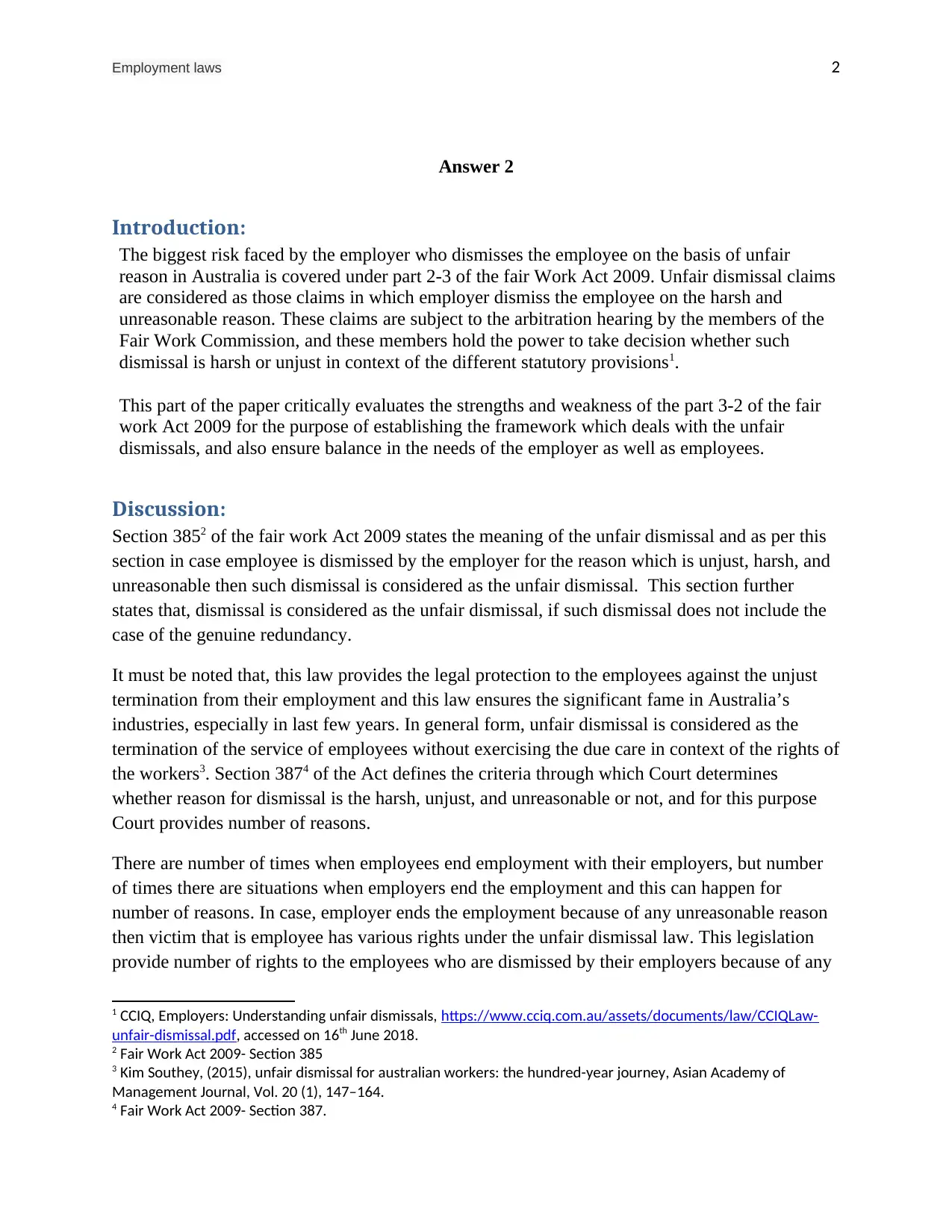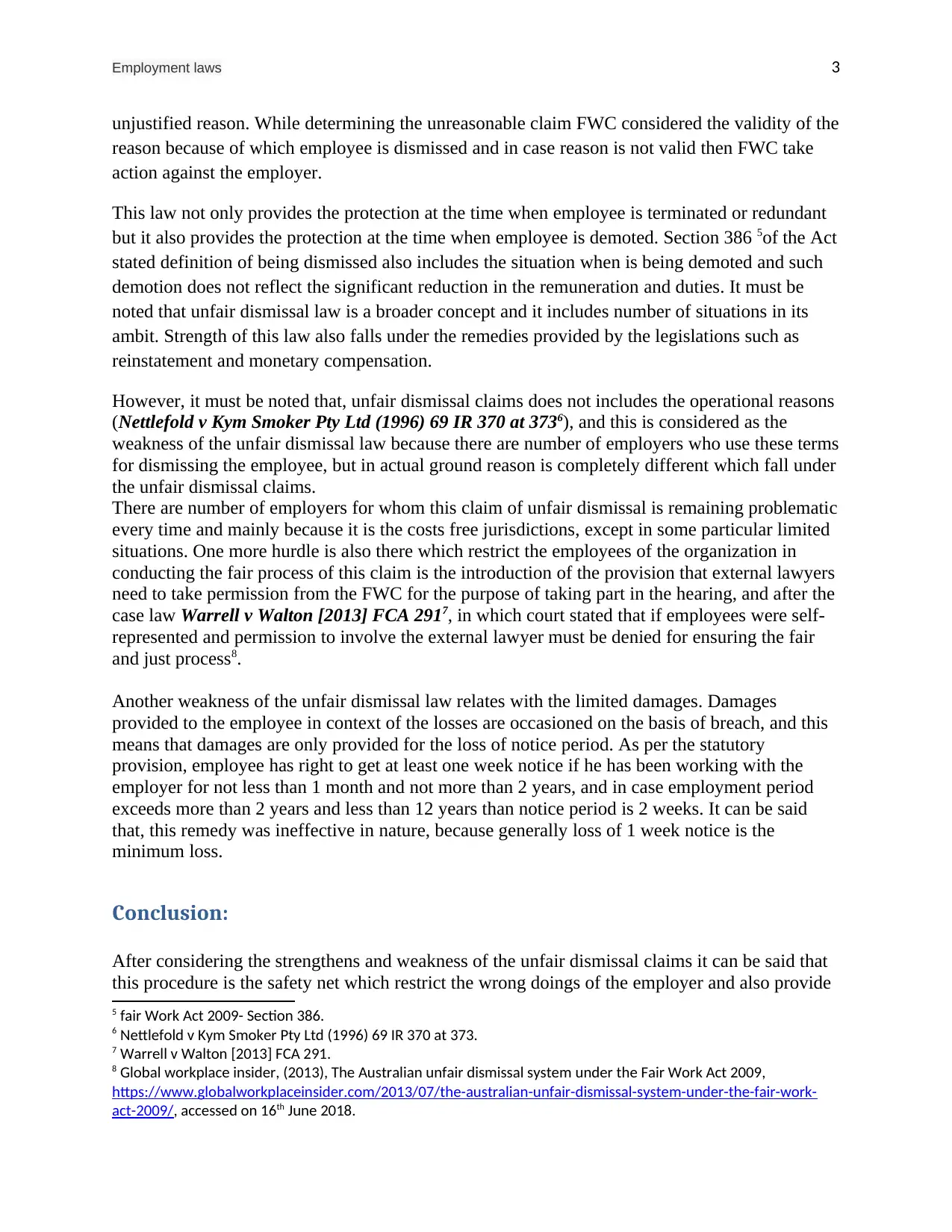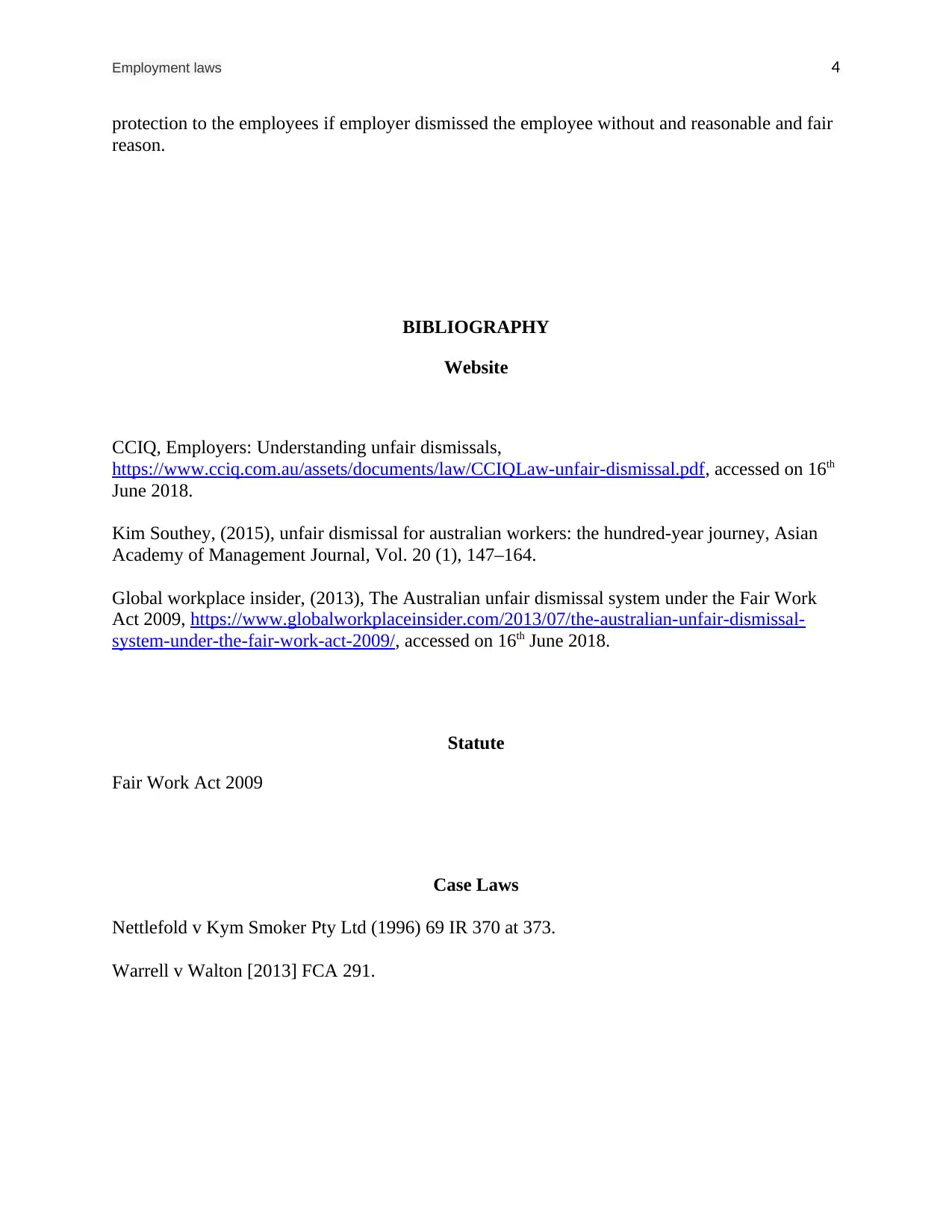LAW 330: Evaluating Unfair Dismissal under the Fair Work Act 2009
VerifiedAdded on 2023/06/11
|4
|1191
|456
Essay
AI Summary
This essay provides a critical evaluation of Part 3-2 of the Fair Work Act 2009, focusing on its framework for dealing with unfair dismissals and balancing the needs of employers and employees. It discusses Section 385, which defines unfair dismissal, and Section 387, which outlines the criteria for determining if a dismissal is harsh, unjust, or unreasonable. The analysis covers the strengths of the law, such as providing legal protection against unjust termination and remedies like reinstatement and monetary compensation. It also addresses weaknesses, including the exclusion of operational reasons as valid grounds for unfair dismissal claims and limitations on damages. The essay concludes that the unfair dismissal procedure serves as a safety net, protecting employees from unreasonable and unfair dismissals while acknowledging existing limitations.

Employment laws 1
Employment Laws
Employment Laws
Paraphrase This Document
Need a fresh take? Get an instant paraphrase of this document with our AI Paraphraser

Employment laws 2
Answer 2
Introduction:
The biggest risk faced by the employer who dismisses the employee on the basis of unfair
reason in Australia is covered under part 2-3 of the fair Work Act 2009. Unfair dismissal claims
are considered as those claims in which employer dismiss the employee on the harsh and
unreasonable reason. These claims are subject to the arbitration hearing by the members of the
Fair Work Commission, and these members hold the power to take decision whether such
dismissal is harsh or unjust in context of the different statutory provisions1.
This part of the paper critically evaluates the strengths and weakness of the part 3-2 of the fair
work Act 2009 for the purpose of establishing the framework which deals with the unfair
dismissals, and also ensure balance in the needs of the employer as well as employees.
Discussion:
Section 3852 of the fair work Act 2009 states the meaning of the unfair dismissal and as per this
section in case employee is dismissed by the employer for the reason which is unjust, harsh, and
unreasonable then such dismissal is considered as the unfair dismissal. This section further
states that, dismissal is considered as the unfair dismissal, if such dismissal does not include the
case of the genuine redundancy.
It must be noted that, this law provides the legal protection to the employees against the unjust
termination from their employment and this law ensures the significant fame in Australia’s
industries, especially in last few years. In general form, unfair dismissal is considered as the
termination of the service of employees without exercising the due care in context of the rights of
the workers3. Section 3874 of the Act defines the criteria through which Court determines
whether reason for dismissal is the harsh, unjust, and unreasonable or not, and for this purpose
Court provides number of reasons.
There are number of times when employees end employment with their employers, but number
of times there are situations when employers end the employment and this can happen for
number of reasons. In case, employer ends the employment because of any unreasonable reason
then victim that is employee has various rights under the unfair dismissal law. This legislation
provide number of rights to the employees who are dismissed by their employers because of any
1 CCIQ, Employers: Understanding unfair dismissals, https://www.cciq.com.au/assets/documents/law/CCIQLaw-
unfair-dismissal.pdf, accessed on 16th June 2018.
2 Fair Work Act 2009- Section 385
3 Kim Southey, (2015), unfair dismissal for australian workers: the hundred-year journey, Asian Academy of
Management Journal, Vol. 20 (1), 147–164.
4 Fair Work Act 2009- Section 387.
Answer 2
Introduction:
The biggest risk faced by the employer who dismisses the employee on the basis of unfair
reason in Australia is covered under part 2-3 of the fair Work Act 2009. Unfair dismissal claims
are considered as those claims in which employer dismiss the employee on the harsh and
unreasonable reason. These claims are subject to the arbitration hearing by the members of the
Fair Work Commission, and these members hold the power to take decision whether such
dismissal is harsh or unjust in context of the different statutory provisions1.
This part of the paper critically evaluates the strengths and weakness of the part 3-2 of the fair
work Act 2009 for the purpose of establishing the framework which deals with the unfair
dismissals, and also ensure balance in the needs of the employer as well as employees.
Discussion:
Section 3852 of the fair work Act 2009 states the meaning of the unfair dismissal and as per this
section in case employee is dismissed by the employer for the reason which is unjust, harsh, and
unreasonable then such dismissal is considered as the unfair dismissal. This section further
states that, dismissal is considered as the unfair dismissal, if such dismissal does not include the
case of the genuine redundancy.
It must be noted that, this law provides the legal protection to the employees against the unjust
termination from their employment and this law ensures the significant fame in Australia’s
industries, especially in last few years. In general form, unfair dismissal is considered as the
termination of the service of employees without exercising the due care in context of the rights of
the workers3. Section 3874 of the Act defines the criteria through which Court determines
whether reason for dismissal is the harsh, unjust, and unreasonable or not, and for this purpose
Court provides number of reasons.
There are number of times when employees end employment with their employers, but number
of times there are situations when employers end the employment and this can happen for
number of reasons. In case, employer ends the employment because of any unreasonable reason
then victim that is employee has various rights under the unfair dismissal law. This legislation
provide number of rights to the employees who are dismissed by their employers because of any
1 CCIQ, Employers: Understanding unfair dismissals, https://www.cciq.com.au/assets/documents/law/CCIQLaw-
unfair-dismissal.pdf, accessed on 16th June 2018.
2 Fair Work Act 2009- Section 385
3 Kim Southey, (2015), unfair dismissal for australian workers: the hundred-year journey, Asian Academy of
Management Journal, Vol. 20 (1), 147–164.
4 Fair Work Act 2009- Section 387.

Employment laws 3
unjustified reason. While determining the unreasonable claim FWC considered the validity of the
reason because of which employee is dismissed and in case reason is not valid then FWC take
action against the employer.
This law not only provides the protection at the time when employee is terminated or redundant
but it also provides the protection at the time when employee is demoted. Section 386 5of the Act
stated definition of being dismissed also includes the situation when is being demoted and such
demotion does not reflect the significant reduction in the remuneration and duties. It must be
noted that unfair dismissal law is a broader concept and it includes number of situations in its
ambit. Strength of this law also falls under the remedies provided by the legislations such as
reinstatement and monetary compensation.
However, it must be noted that, unfair dismissal claims does not includes the operational reasons
(Nettlefold v Kym Smoker Pty Ltd (1996) 69 IR 370 at 3736), and this is considered as the
weakness of the unfair dismissal law because there are number of employers who use these terms
for dismissing the employee, but in actual ground reason is completely different which fall under
the unfair dismissal claims.
There are number of employers for whom this claim of unfair dismissal is remaining problematic
every time and mainly because it is the costs free jurisdictions, except in some particular limited
situations. One more hurdle is also there which restrict the employees of the organization in
conducting the fair process of this claim is the introduction of the provision that external lawyers
need to take permission from the FWC for the purpose of taking part in the hearing, and after the
case law Warrell v Walton [2013] FCA 2917, in which court stated that if employees were self-
represented and permission to involve the external lawyer must be denied for ensuring the fair
and just process8.
Another weakness of the unfair dismissal law relates with the limited damages. Damages
provided to the employee in context of the losses are occasioned on the basis of breach, and this
means that damages are only provided for the loss of notice period. As per the statutory
provision, employee has right to get at least one week notice if he has been working with the
employer for not less than 1 month and not more than 2 years, and in case employment period
exceeds more than 2 years and less than 12 years than notice period is 2 weeks. It can be said
that, this remedy was ineffective in nature, because generally loss of 1 week notice is the
minimum loss.
Conclusion:
After considering the strengthens and weakness of the unfair dismissal claims it can be said that
this procedure is the safety net which restrict the wrong doings of the employer and also provide
5 fair Work Act 2009- Section 386.
6 Nettlefold v Kym Smoker Pty Ltd (1996) 69 IR 370 at 373.
7 Warrell v Walton [2013] FCA 291.
8 Global workplace insider, (2013), The Australian unfair dismissal system under the Fair Work Act 2009,
https://www.globalworkplaceinsider.com/2013/07/the-australian-unfair-dismissal-system-under-the-fair-work-
act-2009/, accessed on 16th June 2018.
unjustified reason. While determining the unreasonable claim FWC considered the validity of the
reason because of which employee is dismissed and in case reason is not valid then FWC take
action against the employer.
This law not only provides the protection at the time when employee is terminated or redundant
but it also provides the protection at the time when employee is demoted. Section 386 5of the Act
stated definition of being dismissed also includes the situation when is being demoted and such
demotion does not reflect the significant reduction in the remuneration and duties. It must be
noted that unfair dismissal law is a broader concept and it includes number of situations in its
ambit. Strength of this law also falls under the remedies provided by the legislations such as
reinstatement and monetary compensation.
However, it must be noted that, unfair dismissal claims does not includes the operational reasons
(Nettlefold v Kym Smoker Pty Ltd (1996) 69 IR 370 at 3736), and this is considered as the
weakness of the unfair dismissal law because there are number of employers who use these terms
for dismissing the employee, but in actual ground reason is completely different which fall under
the unfair dismissal claims.
There are number of employers for whom this claim of unfair dismissal is remaining problematic
every time and mainly because it is the costs free jurisdictions, except in some particular limited
situations. One more hurdle is also there which restrict the employees of the organization in
conducting the fair process of this claim is the introduction of the provision that external lawyers
need to take permission from the FWC for the purpose of taking part in the hearing, and after the
case law Warrell v Walton [2013] FCA 2917, in which court stated that if employees were self-
represented and permission to involve the external lawyer must be denied for ensuring the fair
and just process8.
Another weakness of the unfair dismissal law relates with the limited damages. Damages
provided to the employee in context of the losses are occasioned on the basis of breach, and this
means that damages are only provided for the loss of notice period. As per the statutory
provision, employee has right to get at least one week notice if he has been working with the
employer for not less than 1 month and not more than 2 years, and in case employment period
exceeds more than 2 years and less than 12 years than notice period is 2 weeks. It can be said
that, this remedy was ineffective in nature, because generally loss of 1 week notice is the
minimum loss.
Conclusion:
After considering the strengthens and weakness of the unfair dismissal claims it can be said that
this procedure is the safety net which restrict the wrong doings of the employer and also provide
5 fair Work Act 2009- Section 386.
6 Nettlefold v Kym Smoker Pty Ltd (1996) 69 IR 370 at 373.
7 Warrell v Walton [2013] FCA 291.
8 Global workplace insider, (2013), The Australian unfair dismissal system under the Fair Work Act 2009,
https://www.globalworkplaceinsider.com/2013/07/the-australian-unfair-dismissal-system-under-the-fair-work-
act-2009/, accessed on 16th June 2018.
⊘ This is a preview!⊘
Do you want full access?
Subscribe today to unlock all pages.

Trusted by 1+ million students worldwide

Employment laws 4
protection to the employees if employer dismissed the employee without and reasonable and fair
reason.
BIBLIOGRAPHY
Website
CCIQ, Employers: Understanding unfair dismissals,
https://www.cciq.com.au/assets/documents/law/CCIQLaw-unfair-dismissal.pdf, accessed on 16th
June 2018.
Kim Southey, (2015), unfair dismissal for australian workers: the hundred-year journey, Asian
Academy of Management Journal, Vol. 20 (1), 147–164.
Global workplace insider, (2013), The Australian unfair dismissal system under the Fair Work
Act 2009, https://www.globalworkplaceinsider.com/2013/07/the-australian-unfair-dismissal-
system-under-the-fair-work-act-2009/, accessed on 16th June 2018.
Statute
Fair Work Act 2009
Case Laws
Nettlefold v Kym Smoker Pty Ltd (1996) 69 IR 370 at 373.
Warrell v Walton [2013] FCA 291.
protection to the employees if employer dismissed the employee without and reasonable and fair
reason.
BIBLIOGRAPHY
Website
CCIQ, Employers: Understanding unfair dismissals,
https://www.cciq.com.au/assets/documents/law/CCIQLaw-unfair-dismissal.pdf, accessed on 16th
June 2018.
Kim Southey, (2015), unfair dismissal for australian workers: the hundred-year journey, Asian
Academy of Management Journal, Vol. 20 (1), 147–164.
Global workplace insider, (2013), The Australian unfair dismissal system under the Fair Work
Act 2009, https://www.globalworkplaceinsider.com/2013/07/the-australian-unfair-dismissal-
system-under-the-fair-work-act-2009/, accessed on 16th June 2018.
Statute
Fair Work Act 2009
Case Laws
Nettlefold v Kym Smoker Pty Ltd (1996) 69 IR 370 at 373.
Warrell v Walton [2013] FCA 291.
1 out of 4
Related Documents
Your All-in-One AI-Powered Toolkit for Academic Success.
+13062052269
info@desklib.com
Available 24*7 on WhatsApp / Email
![[object Object]](/_next/static/media/star-bottom.7253800d.svg)
Unlock your academic potential
Copyright © 2020–2025 A2Z Services. All Rights Reserved. Developed and managed by ZUCOL.




